REVIEWS |
|||||||
I've read most of the books in my library, and I think the Birthing from Within is something that you either need to apply or go to one of the classes to make it seem a little less...well, "out there". Know what i mean? Either you have to immerse yourself in it and embrace it in a setting where everyone else is, too or you just don't get into it. I skimmed it, but really, unless i were applying it in a group setting, most people I know wouldn't be into it. The books I'm really enjoying are the ones most centered on postpartum--the ones that employ methods of really getting mom/baby to connect...one GREAT one I just picked up was Childbirth Wisdom (about other cultures' preg., childbirth, and PP). 08-19-2007, 01:38 PM - www.doulas.com This book was written because the author asked the questions: "what was birth like before hospitals?" and "what lessons might we learn from traditional societies?" The book alternates between author commentary and vignettes designed to vividly convey the information for that society. During pregnancy, traditional societies have support of the abdomen, massage, and no expectations of birth in exactly nine months. For the birth, they create an environment designed to relax the mother, encourage walking, exercise, changing positions, steaming or lubrication of the perineum, and a birth position that uses gravity. The cord is not cut until the placenta is out and the baby is breathing well. The newborn is treated gently and birthed into a semi-dark, warm, and quiet environment. If the baby is not breathing well then submerge into a cold bath. Postpartum care would include massage, walking, keeping mother’s upper body elevated, and heat treatments. Nursing would be on demand. The mother and infant would always be close-during the day the infant is carried and at night sleeps with the mother. Infant massage is used. Weaning occurs gradually. The average nursing period is listed as two to three years with some cultures nursing substantially longer. One culture, Blackfeet of the North American Plains, nursed until six years of age. The author notes that there is much that modern society can learn from the wisdom of our ancestors. Current childbirth practices can be altered to include this wisdom without loosing the benefits of technology and in most cases the technology would not be necessary if the wisdom is used. |
"Long before Hippocrates began
compiling the knowledge
that is the basis for modern medicine,
far older societies were accumulating and passing down
a legacy of folk wisdom whose applications
are still relevant for childbirth today. "Childbirth Wisdom, an anthropological look at birthing lore from nearly five hundred traditional cultures (with the footnotes to prove it), provides the modern reader with an intriguing contrast to the outlook of modern obstetrics. "Take birthweight: in postwar America, birthweight is one measure used to determine a newborn's relative health; the bigger the better, as we see it. But in tribal societies, expectant mother's carefully moderate their dietary intake so that their babies will not be difficult to birth. "Now, a seven-pound baby is not unhealthy - and the difference between giving birth to a seven-pound baby and to a nine-pound baby may be one of many hours. "It kind of makes you wonder." - Patriciia DiLucchio, The Millenium Whole Earth Catalog, Spring 1994, page 187 ---------------------------------------------------------- What is "natural" childbirth? Modern Americans would tend to answer that question with an explanation of breath- ing patterns and moderate use of anaesthetic drugs, if they could answer the question at all. After a reading of Childbirth Wisdom, Judith Goldsmith's anthropological treatment of birth in traditional cultures, the Lamaze and Bradley methods of labor seem as unnatural and un- necessary as much of modern obstetrics. Goldsmith reviewed the childbirth practices of nearly 500 cultures as diverse as the Chukchee of Siberia and the Maori of New Zealand. In spite of the tremendous varia- tion of detail from group to group, she found a remarkable consistency: childbirth in these "minimal-technology" cultures is brief, relatively pain-free, joyful, and safe. In comparision, the complications and morbidity rates of Western obstetrics are rather dismal. The author provides a summary of practices, and divides her reference notes into sections by both practice (delivery of the placenta, breast-feeding, etc.) and culture. Extensively researched. - Sallie Tisdale - WER 1988 #58, page 91 ---------------------------------------------------------- We also know that the diet of the breastfeeding mother affects the quality of her milk. For instance, the alcohol from a single drink consumed by a nursing mother appears in the breast milk in the same concentration as the mother's blood within 30 minutes. Women who eat foods that are heavily laden in pesticides will pass traces of those substances into their milk. Nicotine ingested by a nursing mother who smokes cigarettes passes into the breast milk as well. Foods eaten by mom can sometimes disagree with the breast-fed child; especially high-dosage vitamins, supplements high in iron, artificial sweeteners, caffeine, heavily spiced foods, and occasionally dairy products. Colicky or fussy babies may improve by changing the nursing mother's diet. Okay so we know there is a relationship between what moms eat and the quality of their milk. By avoiding harmful substances women can produce “cleaner” milk. But instead of focusing on what nursing mother’s should avoid in their diet, let’s explore what to include. What are foods that help produce rich, nourishing milk? To find answers about the best diet for breastfeeding mothers we can look at the post-natal diet of tribal women throughout the world described in Judith Goldsmith’s book Childbirth Wisdom (East West Books, 1990). An amazing consistency of custom emerges. |
||||||


